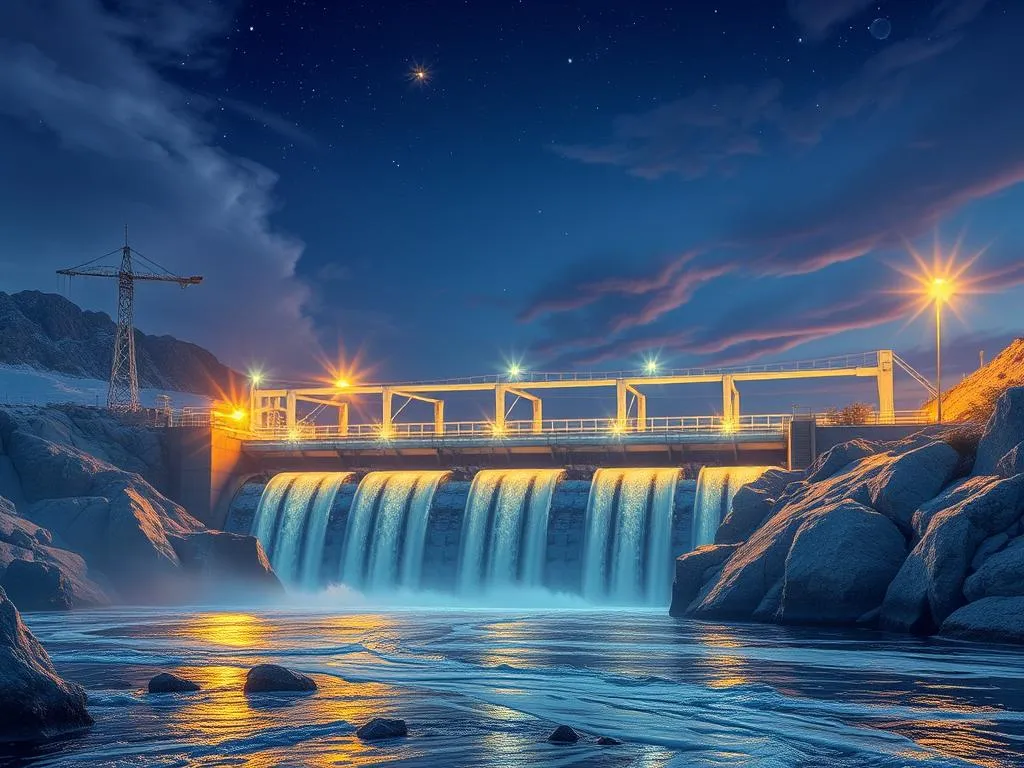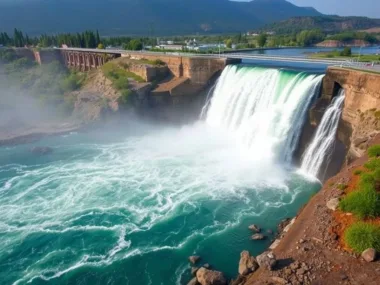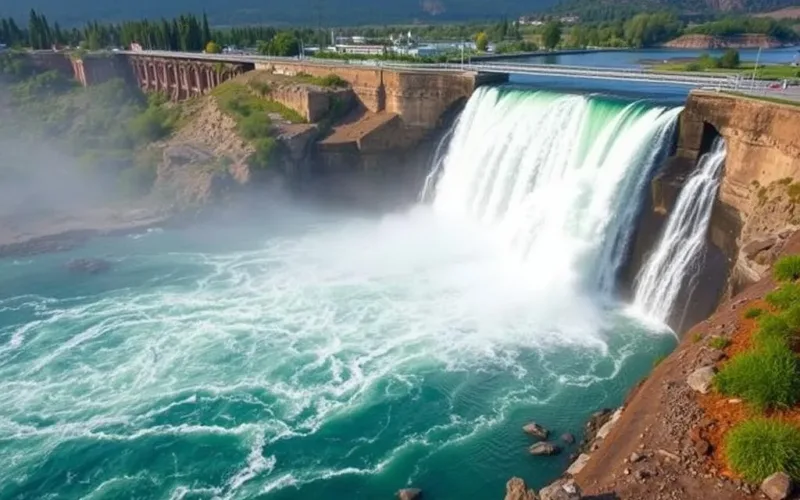Hydro energy pros and cons, or advantages and disadvantages a crucial renewable energy source, harnesses the kinetic energy of water to generate electricity. This article explores the pros and cons of hydroelectric power, including its sustainability, low operating costs, and environmental impacts, while discussing its role in climate change mitigation and future outlook.
Advantages and Disadvantages or Pros and Cons of Hydro Energy
Hydro energy, commonly known as hydroelectric power, stands as one of the oldest and most significant sources of renewable energy, harnessing the kinetic energy of moving water to generate electricity. Globally, it accounts for approximately 15% of electricity production, making it a cornerstone of clean energy strategies (Hydroelectricity – Wikipedia). In the United States, it contributes about 6.2% of total utility-scale electricity and 28.7% of renewable electricity (EIA Hydropower). However, like any energy source, hydroelectric power has both substantial benefits and notable challenges. This article provides a comprehensive exploration of the pros and cons of hydro energy, offering insights into its role in the global energy landscape, its operational mechanics, and the trade-offs that shape its use in 2025.
What Is Hydro Energy?
Hydro energy, or hydroelectric power, is a renewable energy source that generates electricity by capturing the kinetic energy of flowing water. It relies on the natural water cycle, driven by solar energy, which replenishes rivers and reservoirs through precipitation. Hydroelectric power plants convert this energy into electricity using turbines and generators, making it a sustainable alternative to fossil fuels. While the term “hydro energy” can broadly include tidal and wave power. It most commonly refers to hydroelectric power from rivers and dams, which is the focus of this discussion.
How Does Hydroelectric Power Work?
Hydroelectric power plants typically operate by storing water in a reservoir created by a dam. When electricity is needed, water is released, flowing through pipes called penstocks to spin turbines connected to generators. The amount of electricity produced depends on the volume of water flow and the height from which it falls, known as the head. Run-of-river systems, which use the natural flow of a river without large reservoirs, are another approach, offering a less invasive alternative. Pumped-storage facilities provide energy storage by pumping water to a higher reservoir during low demand and releasing it to generate power during peak demand (Department of Energy).
Advantages and Pros of Hydro Energy
Hydroelectric power offers a range of benefits that make it a compelling choice for clean energy production. Below are the key advantages, supported by specific examples and data:
- Renewable and Sustainable: Hydroelectric power is renewable, relying on the water cycle, which is continuously replenished by rainfall and snowmelt. This ensures a sustainable energy supply as long as water resources are available. For instance, Norway generates nearly 99% of its electricity from hydropower, showcasing its potential as a reliable energy source (Hydroelectricity – Wikipedia).
- Low Operating Costs: Once constructed, hydroelectric plants have minimal operating costs. There are no fuel expenses, and maintenance is relatively low compared to fossil fuel plants. The Hoover Dam, for example, has provided cost-effective electricity to the southwestern U.S. for decades, supporting millions of households (EIA Hydropower).
- High Efficiency: Hydroelectric plants can convert up to 90% of water’s kinetic energy into electricity. Far surpassing the efficiency of solar (30-36%), wind (25-45%), or coal (33-40%) (Kiwi Energy). This high efficiency maximizes energy output from available resources.
- Reliability and Flexibility: Hydroelectric power provides a consistent base load of electricity and can be adjusted rapidly to meet peak demand. Pumped-storage systems enhance this flexibility by storing energy for high-demand periods, making hydropower a critical grid stabilizer (Perch Energy).
- Low Greenhouse Gas Emissions: During operation, hydroelectric plants produce negligible greenhouse gas emissions, contributing to cleaner air and climate change mitigation. Globally, hydropower prevents about 3 gigatons of CO2 emissions annually, equivalent to 9% of global CO2 emissions (ScienceDirect).
- Multi-functional Benefits: Dams often serve multiple purposes beyond electricity generation, including flood control, irrigation, water supply, and recreation. The Hoover Dam, for instance, not only powers homes. But also manages flooding and provides water for agriculture in the arid Southwest (Department of Energy).
Disadvantages and Cons of Hydro Energy
Despite its advantages, hydroelectric power presents significant challenges that must carefully managed. Below are the key disadvantages, illustrated with examples and data:
- High Initial Costs: Constructing hydroelectric dams and power plants requires substantial upfront investment, often costing billions of dollars. The Three Gorges Dam in China, the world’s largest, cost over $31 billion, posing a financial barrier for many regions (Wikipedia).
- Environmental Disruption: Large dams can flood extensive areas, disrupting ecosystems, displacing wildlife, and altering river habitats. For example, dams in the U.S. Pacific Northwest have blocked salmon migration routes, contributing to population declines (Union of Concerned Scientists). Run-of-river systems have less impact but still affect local ecosystems.
- Social Impact: Reservoir creation often requires relocating communities, leading to social and cultural disruptions. The Three Gorges Dam displaced over 1.3 million people and submerged numerous archaeological sites. Highlighting the human cost of large projects (International Rivers).
- Dependence on Water Availability: Hydroelectric power relies on sufficient water flow. Which can reduce by droughts or altered by climate change. In the U.S. Southwest, a 22-year megadrought has lowered water levels in Lake Mead, impacting the Hoover Dam’s output (World Wildlife Fund).
- Sedimentation: Sediment accumulation in reservoirs can reduce storage capacity and plant efficiency. While also disrupting downstream ecosystems by limiting natural sediment flow (EIA).
- Risk of Dam Failure: Though rare, dam failures can be catastrophic, causing loss of life and property. Historical examples, like the 1975 Banqiao Dam failure in China, underscore this risk (Britannica).
- Potential Methane Emissions: In tropical regions, decomposing organic matter in reservoirs can produce methane, a potent greenhouse gas. The Balbina Dam in Brazil, for instance, has been criticized for its methane emissions, which offset some climate benefits (Union of Concerned Scientists).
The Role of Hydro Energy in Climate Change
Hydroelectric power is a key player in climate change mitigation, avoiding up to 4 billion tonnes of greenhouse gas emissions annually compared to coal plants (Hydropower.org). However, it is vulnerable to climate change impacts, such as altered precipitation patterns and increased droughts, which can reduce water availability. For example, 61% of global hydropower dams projected to face high or extreme drought risk by 2050 (World Wildlife Fund). Mitigation strategies, like fish ladders and sediment management, can help address environmental concerns, while small-scale or run-of-river projects offer less invasive alternatives.
Future Outlook
The future of hydroelectric power lies in balancing its benefits with sustainable practices. Innovations like fish-friendly turbines and advanced sediment management can reduce environmental impacts. Small-scale projects and run-of-river systems are gaining traction as less disruptive options. As the world transitions to clean energy, hydroelectric power will remain a vital component, but its development must prioritize ecological and social considerations to ensure long-term viability.
Conclusion
Hydro Energy or Hydroelectric power is a cornerstone of renewable energy, offering significant pros and cons, or advantages and disadvantages, such as sustainability, low operating costs, high efficiency, and minimal emissions. It supports climate change mitigation by reducing greenhouse gas emissions and provides multi-functional benefits like flood control and irrigation. However, its challenges—high initial costs, environmental disruption, social impacts, and vulnerability to climate change—require careful management. The decision to invest in hydroelectric projects should weigh these trade-offs, considering local conditions and sustainable practices. With advancements in technology and planning, hydroelectric power can continue to play a critical role in the global shift to clean energy, provided its impacts are addressed responsibly.













Leave a Reply